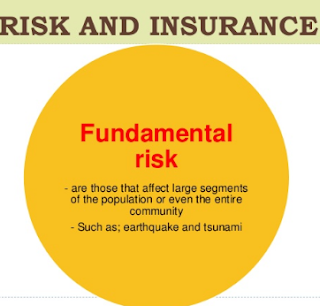Fundamental and Particular Risks
Fundamental
and Particular Risks
The
distinction between fundamental and partiCUlar risks is based on the concept
of
hazard defined by Kulp. Particular risks involve losses that arise out of
individual events and are felt by individuals rather than a group.
Fundamental
risks involve losses that affect a large segment of the population. The later
are caused for the most part by economic, social, climatic, health and/or
political phenomena. Examples are wars, earthquakes, health diseases, economic
recessions leading to unemployment.
Fundamental risks may be static or dynamic.Systematic
and Unsystematic Risks
This
is a basic principle in financial management: risk can be eliminated through
diversification.
Diversification reduces risks if all the outcomes of risky events
do
not produce the same result or do not arise all at the same time. The
convention
in finance is to interpret risk in the spirit of Willet and Knight. A
risky
outcome is one that can assure a number of values. It is interesting to note
that
Knight in 1921 defined profit as a reward for assuming risk and claimed
that
only uncertainties create an economic problem and are the source of
economic
profit.
In
1952, Markowitz, known as the father of modem portfolio theory,
published
an article showing the exact relationship between stock return
correlation
and risk reduction.16 He recognized that a set of securities can be
combined
into an infinite number of portfolios with a wide range of risk-return
combinations.
Risk that is eliminated through diversification is risk that is
unique
to the stock or group of stocks in the portfolio. Unique risk is known as
diversifiable
or msystematic risk. Because it can be eliminated, it should have
no
value.
No
matter how well diversified a portfolio is, there is some unavoidable
component
of risk that exists because certain factors systematically affect all
firms
in the economy to a greater or lesser extent. This risk is known as market
or
systematic risk This leads to one of the most important insights of modem
finance
theory: because the risk of a well-diversified portfolio depends only on
5
the
market risk of its components securities, the relevant risk of any security is
its
sensitivity to general market movements.
Country
and International Risks
In
its broader sense, country risk can be defined as potential financial losses
due
to
problems arising from macro-economic andJor political events in a particular
country.
At
the country level, business risks are essentially classified as operating
risks,
socio-political risks and financial risks. Operating risks are those
concerning
the local economic, technical, infrastructural and cultural
environment
while socio-political risks are those concerning the host
government
and its policies, programs and practices. For example, changes in
Governments
may result in changes of behavior or attitudes towards
nationalistic
interests.
Financial
risks reflect the possibility that even though the investment is
generating
a cash flow in local currency, foreign exchange controls or problems
may
limit the transfer of funds. This is often referred as sovereign risk or
transfer
risk.
Country
risk by nature is it dynamic risk. Unexpected events play against a
background
of shifting trends. Country risk is also mainly a diversifiable risk.
However,
external factors and mainly international factors too can alter
unexpectedly
and transform perception of a country risk. In the 1970s oil
played
a major role in the international scene. Perception of risks, therefore, is
inevitably
subject to change depending on the way the world economy and
international
policies unfold.



